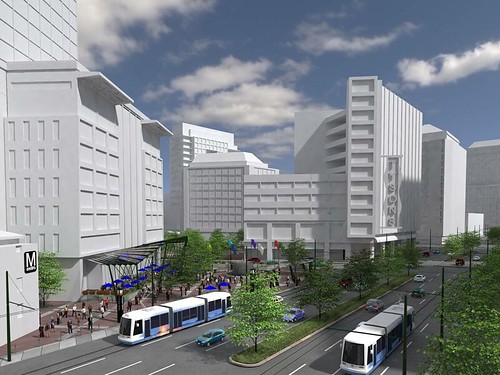Ever try to walk to Tysons Corner? Clark Tyler has, and he vividly remembers attempting to get to Tysons by foot from his nearby home.
“It was the dumbest thing I ever did,” he says, describing his harrowing experience crossing roads in the Tysons area.
Tyler, who chairs the Tysons Land Use Task Force, thinks the region’s retail mecca and surrounding commercial space could do with some improvement, and he wasn’t alone among a group of 45 people gathered to tour Tysons Corner by foot last Saturday.
The walking tour, led by Stewart Schwartz, the executive director of the Coalition for Smarter Growth, provided attendees with a first-hand pedestrian perspective of the area as it is today and a walking discussion of what’s in store for Tysons in the future.
Schwartz and his staff guided the tour from the mall to a nearby office building, pointing out the kind of obstacles that make walking unpleasant—incomplete sidewalks, broken or badly-timed walk signals, “goat trails” on the grass, dangerous intersections, and intimidating crosswalks across major roadways.
“Highways that speed people through tend to be barriers [to pedestrians],” Schwartz says.
But pedestrian concerns aren’t the full picture. In a few years Tysons Corner is scheduled to have four Metro stations and direct access to the Beltway’s high-occupancy/toll lanes, with which planners aim to transform Tysons Corner into a real city.
The proposal, which was approved Tuesday by Fairfax County officials, envisions Tysons with transit-oriented districts and a grid-like street system. Denser and taller, mixed-use development would be positioned around the Metro stations. In areas farther from the stations, development would “tier down to the surrounding residential areas,” explains Barbara Byron, a representative from the county’s Office of Community Revitalization and Reinvestment.
"Getting in and out is really a challenge," says Byron, referring to the difficulty of urbanizing Tysons without making traffic worse. Planners hope to reduce vehicle trips in the long term by 45 to 65 percent, according to Byron's presentation, and to do so, they have to think of ways to get people out of their cars, such as better transit, walkability, and amenities for bicyclists.
 There's been a “philosophy shift from parking minimums to parking maximums” among planners for Tysons, she says.
There's been a “philosophy shift from parking minimums to parking maximums” among planners for Tysons, she says.Bruce Wright, chairman of Fairfax Advocates for Better Bicycling, and who also walked the tour, spoke out for better bicycling facilitates, especially on Routes 123 and 7 -- central roadways in the current plan that lack bicycle facilities. He also suggested setting up a bike-sharing system, a concept that’s taking hold around the world and in neighboring jurisdictions.
"There are ways for us to avoid getting in huge cars to go short distances," he notes.
The hope shared by many of the tour’s organizers and participants is that the redevelopment of Tysons Corner will complement the commercial success of existing retail while making the area a more walkable, less car dependent place than it is now.
“How does it feel to be a pedestrian? Feel like an endangered species?” Schwartz called out to the group, trying to make himself heard over the cars at a busy intersection. “That’s what we’re trying to change.”
[This article originally appeared on the Annandale blog.]
[This article originally appeared on the Annandale blog.]
Photo credits:
- Skyline of Tysons Corner, Va. Image from Wikipedia.
- Some streets in Tysons don't have sidewalks, so tour participants walked on the road when necessary. Image from the Coalition for Smarter Growth via Flickr.
- Rendering of proposed redevelopment. Image from the county's "Transforming Tysons" website via Flickr.





No comments:
Post a Comment